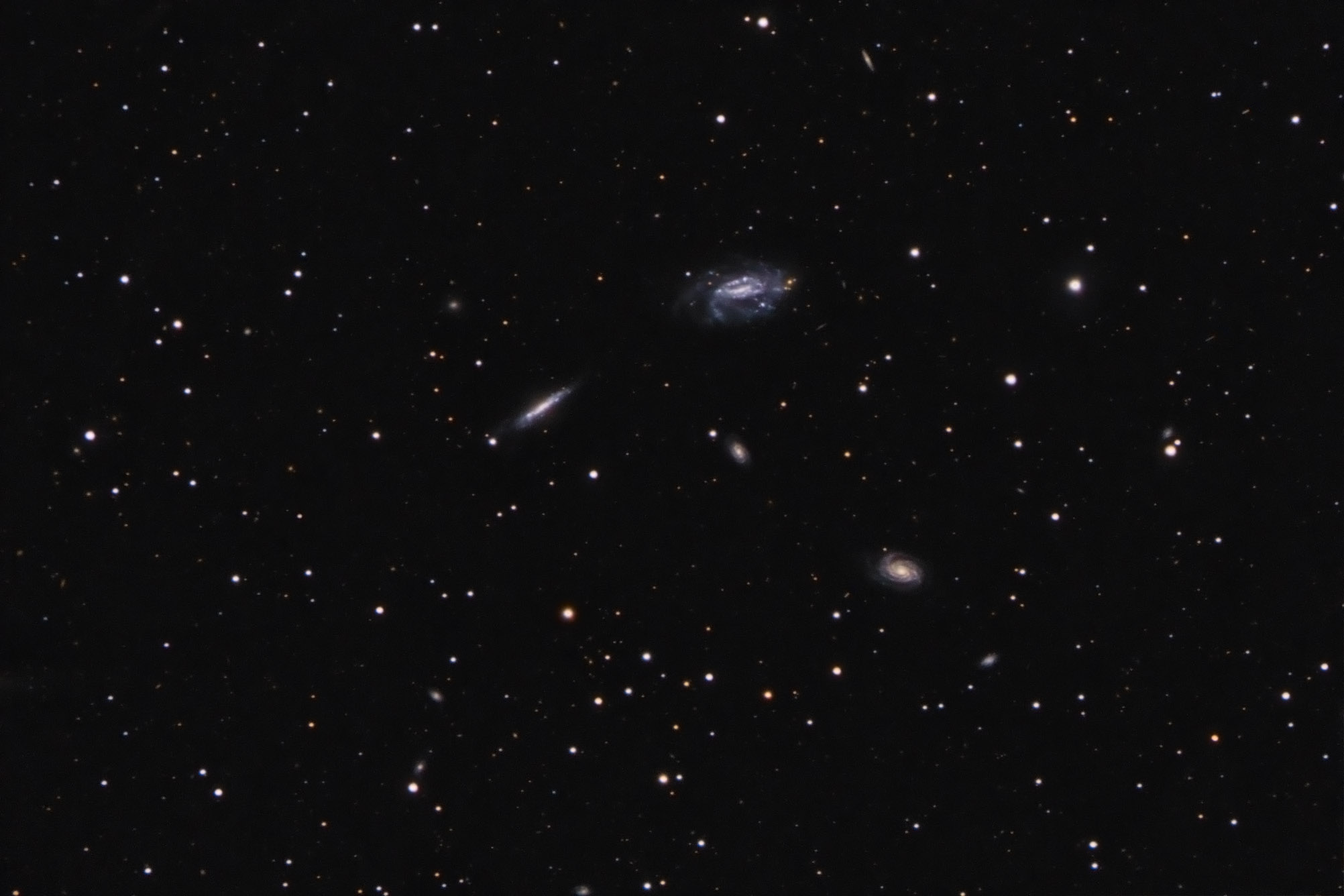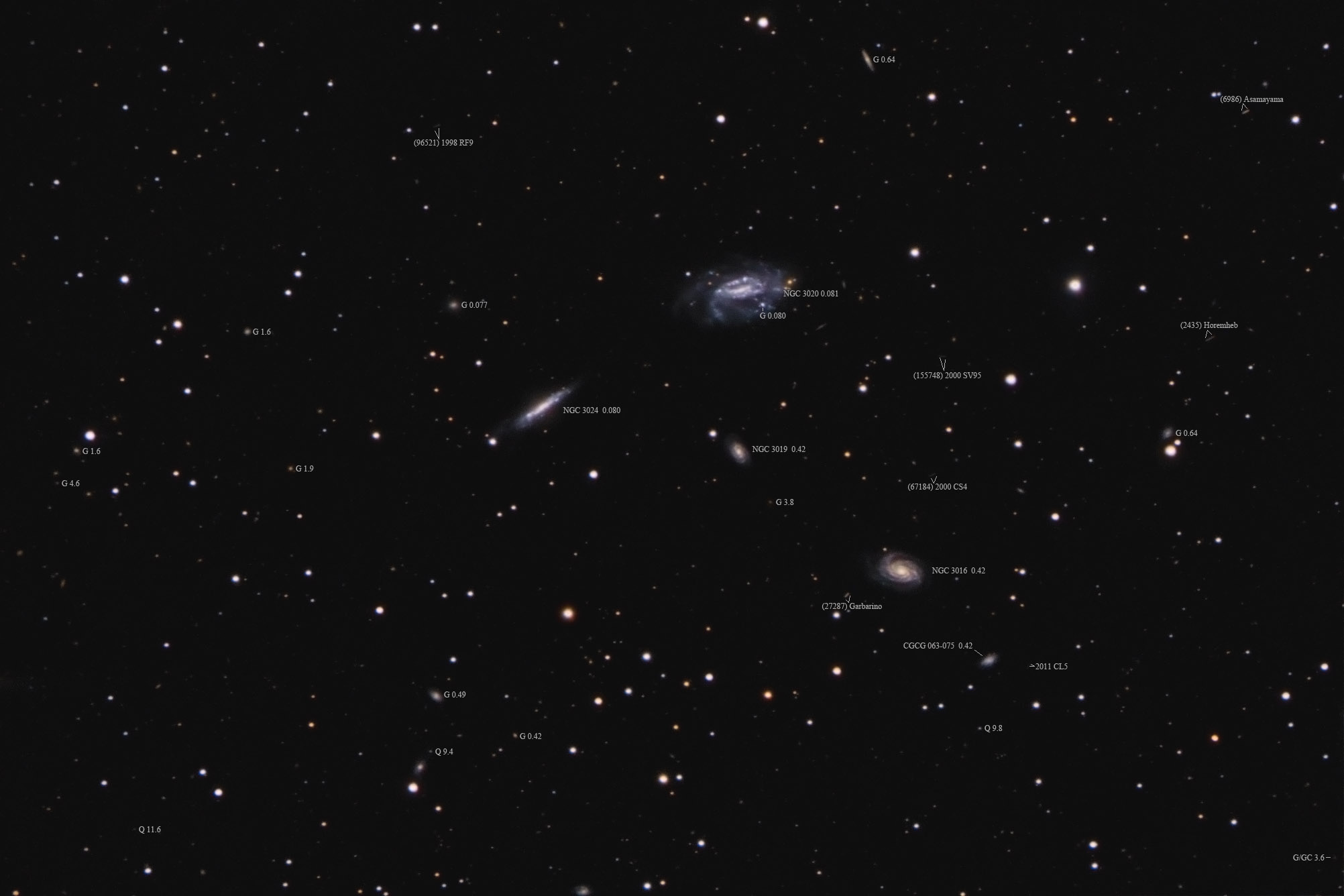Object name: NGC3020Designation(s): NGC3020, NGC3016, NGC3019, NGC3024, NGC 3016, 3019, 3020, 3024 is a 4 galaxy group according to many catalogs. Really it is a pair of two galaxy groups as the first two have a redshift putting them 420 million light-years from us while the last two are much closer at about 80 million light-years. I see no sign of interaction between the latter pair but the more distant pair may have had a minor interaction in the past. NGC 3019 has a plume on the northeast end while NGC 3016 has a rather unsymmetrical arm structure. This may be a coincidence.
NGC 3016 and NGC 3019 were discovered by R. J. Mitchell on March 21, 1854.
NGC 3020 and NGC 2324 were discovered on March 19, 1784 by William Herschel but neither is in either H400 program.
These galaxies are located in Leo. NGC 3016 is classed as Sb by both NED and the NGC project. NGC 3019 is an obvious spiral but not classed by NED. However, the NGC project says Sbc. NGC 3020 is classed as SB(r)cd by NED and SBc by the NGC Project. It is very splotchy with ill-defined form. NGC 3024 is listed as Sc by NED and simply S by the NGC project. Being so close to edge on judging the arm structure is difficult.
As mentioned, NGC 3020 is full of knots. There's an orange star at the western end that could pass for a separate galaxy. One blue spot in the galaxy is listed by the SDSS as a separate galaxy, SDSS J095004.52+124826.6. Its redshift is virtually the same as that of NGC 3020. Another knot is listed as part of the galaxy. I really see no difference between this one classed as a galaxy and others that are considered knots in the galaxy. I've marked it on the annotated image, whatever it is.
There appears to be a third member of the NGC 3020-24 group. It is a dwarf northeast of NGC 3024. It is apparently a radio galaxy as it is AGC 192239. AGC is the Arecibo General Catalog. Is it strong in the radio frequencies because it interacted with one of the other two or is this just natural to the galaxy? I don't know.
The image contains 7 asteroids down to 21st magnitude. Several others are seen in the raw FIT image stack but are very faint unless stretched further than the rest of the field needs. The seven are identified in the annotated image. I've listed them below along with their estimated magnitude from the Minor Planet Center.
(96521) 1998 RF9 20.0
(155748) 2000 SV95 19.6
(67184) 2000 CS4 19.7
(27287) Garbarino 18.5
(2435) Horemheb 19.1
(6986) Asamayama 18.0
2011 CL5 21.0
The name citations for the three named asteroids read:
(27287) Garbarino = 2000 AC112
Guido Garbarino mentored a finalist in the 2011 Intel Science Talent Search, a science competition for high-school seniors. He teaches at the Mamaroneck High School, Mamaroneck, New York, U.S.A.
(2435) Horemheb = 4578 P-L
Named for the last pharaoh of the eighteenth dynasty in ancient Egypt. His tomb was recently excavated by a joint British-Dutch expedition.
(6986) Asamayama = 1994 WE
Mt. Asamayama is a triplex stratovolcano at the border of Gunma and Nagano prefectures, with an altitude of 2565 m above sea level. It has a 350-m-diameter crater called "Okama", where smoke still rises. It is known as one of the most active volcanoes in Japan.
The galaxy cluster in the southwest (lower right) corner of the image is GMBCG J147.27767+12.57316 at 3.6 billion light-years. Again no size is given. It contains 10 members according to NED. Only the BCG seems visible in the image though there's a hint of something right beside it to the east so I drew the line a bit further from the galaxy than normal so as not to hide this faint whatever. Doesn't look like noise. The cluster may run off the edge of the image.
14" LX200R @ f/10, L=4x10' RGB=2x10'x3, STL-11000XM, Paramount ME Related Designation(s):2MASS J09495066+1241426, 2MASS J09500659+1248492, 2MASS J09500718+1244461, 2MASS J09502736+1245563, 2MASS J09502743+1245554, 2MASX J09495067+1241429, 2MASX J09500659+1248489, 2MASX J09500721+1244459, 2MASX J09502739+1245562, 2MFGC 07618, AGC 190543, ASK 428681.0, ASK 428685.0, ASK 428710.0, ASK 644137.0, CGCG 063-077, CGCG 063-081, CGCG 063-082, CGCG 063-084, CGCG 0947.1+1256, CGCG 0947.4+1258, CGCG 0947.4+1303, CGCG 0947.8+1300, GALEXASC J095006.62+124848.2 , GALEXASC J095007.23+124446.7 , GALEXASC J095027.38+124556.1 , GALEXMSC J095006.63+124848.2 , GALEXMSC J095007.23+124446.4 , GALEXMSC J095027.36+124556.2 , GASS 26056, GB6 J0950+1249, HOLM 147A, HOLM 147B, HOLM 147C, HOLM 147D, IRAS 09471+1255, IRAS 09474+1302, IRAS 09477+1259, KTG 27A, KTG 27B, KTG 27C, MCG +02-25-040, MCG +02-25-044, MCG +02-25-045, MCG +02-25-046, NGC 3016, NGC 3019, NGC 3020, NGC 3024, NGC3016, NGC3019, NGC3020, NGC3024, NSA 074041, NSA 116426, NSA 157473, NSA 157477, NVSS J094950+124142, NVSS J095027+124556, PGC 028269, PGC 028295, PGC 028296, PGC 028324, SDSS J094950.65+124142.7, SDSS J094950.65+124142.8, SDSS J094950.66+124142.8, SDSS J095006.63+124848.9, SDSS J095006.64+124848.9, SDSS J095007.20+124446.0, SDSS J095007.21+124446.1, SDSS J095027.38+124555.7, SDSS J095027.39+124555.7, SDSS J095027.40+124555.8, UGC 05266, UGC 05271, UGC 05275, UZC J094950.6+124143, UZC J095006.6+124849, UZC J095007.2+124446, UZC J095027.3+124557, WBL 243-002, WBL 243-003, WBL 243-004, WBL 243-005, [M98j] 075 NED01, [M98j] 075 NED02, [TTL2012] 096906, [TTL2012] 096910, | | 
